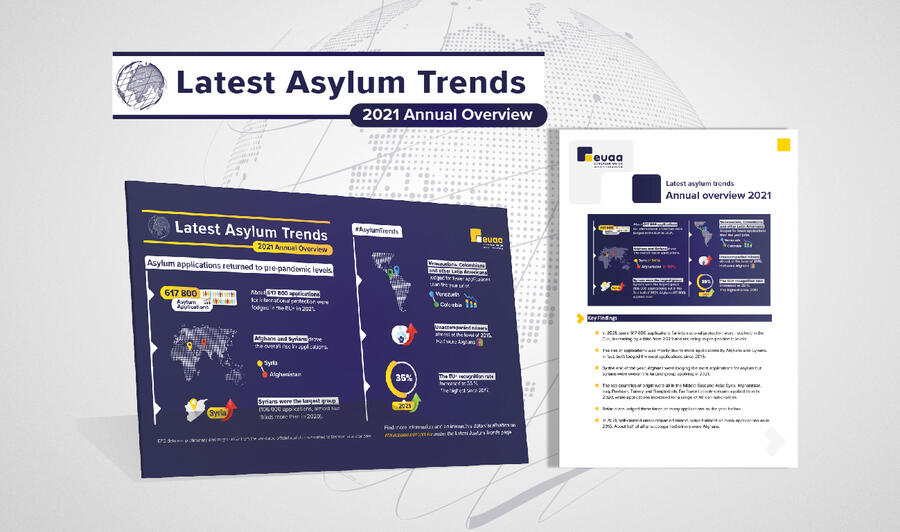News
Press Release Published: 22 February 2022
Asylum applications returned to pre-pandemic levels in 2021

After an unusually low number in 2020, asylum applications in EU+ countries increased by a third in 2021, largely during the second half of the year. This was driven mainly by considerably more Afghan and Syrian applications.
Analysis released by the European Union Agency for Asylum (EUAA) shows that about 617 800 applications for international protection were lodged in the EU+ in 2021.1 This was a third higher than in 2020, when unusually few applications had been lodged during the outbreak of the COVID-19 pandemic. The level in 2021 was roughly in line with pre-pandemic levels between 2017 and 2019. However, repeat applications were especially common in 2021 (the most since at least 2014) and citizens of many of the main countries of origin lodged the most asylum applications in several years.
Top countries of origin are in the Middle East and Asia
Afghans and Syrians drove the overall rise of applications in 2021. Indeed, Afghans lodged twice as many applications (some 97 800) compared to 2020. While Afghans were the largest applicant group in recent months, Syrians were the largest group in 2021, overall: they lodged some 106 000 applications, almost two thirds more than in 2020. Syrians and Afghans both applied the most since 2016, although not nearly as much as during the so-called refugee crisis in 2015/2016.
The other main countries of origin such as Iraq (some 28 700 applications in 2021), Pakistan (24 600), Turkey (23 700) and Bangladesh (20 000) also lodged more applications than in 2020. Somalis, Nigerians, Moroccans and others from East, West and North Africa also applied in substantially higher numbers. In contrast, Venezuelans, Colombians and other Latin Americans lodged far fewer applications in 2021 than a year earlier. Among European applicants, Belarusians tripled their applications, whereas those by nationals of North Macedonia increased fourfold.
Unaccompanied minors almost at the level of 2016
In 2021, EU+ countries received some 27 300 applications by self-proclaimed unaccompanied minors, far more than in any of the prior three years and almost as many as in 2016 (29 300). Almost half of all unaccompanied minors were Afghans (13 000, and the most since 2015), followed by Syrians, Somalis, Bangladeshis and Pakistanis. About one in every 23 asylum applicants in the EU+ claimed to be an unaccompanied minor (4 % of the total).
Rising recognition rate
Asylum authorities in EU+ countries issued about 523 000 decisions at first instance in 2021, in line with 2020. However, the number of applications outnumbered decisions by some 95 000. As a result, cases pending at first instance have increased in recent months to about 442 500 at the end of December 2021. Half of these cases had been pending for less than six months.
The EU+ recognition rate for EU-regulated forms of protection (refugee status and subsidiary protection) increased to 35 % in 2021, the highest since 2017. This was driven by Afghans, whose recognition rate rose substantially: from 53 % in 2020 to 66 % in 2021, temporarily exceeding 90 % in October and November 2021. Recognition rates were also comparatively high for Eritreans (81 %), Yemenis (79 %), Belarusians (75 %) and Syrians (72 %). Almost two thirds of positive-decision recipients were granted refugee status in 2021, while the remainder were granted subsidiary protection.
For more information and an interactive data visualisation, please visit the Latest Asylum Trends page.
Download the findings here.
Any further information may be obtained from the European Union Agency for Asylum’s Press Office at the following email addresses:
- Press Office: press@euaa.europa.eu
- Andrew McKinlay, Press Officer: Andrew.McKinlay@euaa.europa.eu
- Anis Cassar, Spokesperson: Anis.Cassar@euaa.europa.eu
Notes
[1] EUAA EPS data are preliminary and might differ from validated official statistics submitted to Eurostat at a later stage. Eurostat data are used in the annual EUAA Asylum Report. The total EPS numbers may change after data updates.

